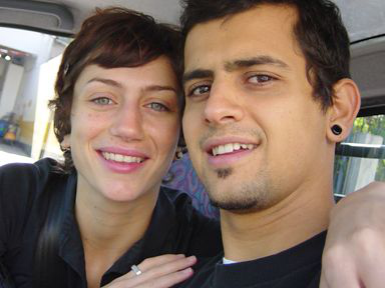Since 60’s, when artist like Paik, Nauman and Vito Acconci used video as a means of registering performances, the electronic means began to sustain a strong relation to the body and its forms of representation. In some moments, the screens and images were closely connected to the body as in TV Bra for living sculpture (1970), by Paik (dedicated to Charlotte Morman), and, in other moments, they were like an attentive, distant look which registered and transformed the performing act into images. This diversity of experiences allows us to realize how the electronic image is becoming a propitious field to expose and reflect on the relation between body and image. In certain moments, there are simple recording, and, in others, there is a kind of prosthesis, or even an invasion.
Gisela Motta and Leandro Lima’s work, which we present in this fourth edition of the FF Dossier, is an heir to this perspective. However, it sometimes stresses the body aspects through an almost direct presentation of the body and the re-recreation of the organism and its surroundings, by the used of digital resources and image processing tools. Their work transcends the merely formal aspects of the representation of the body and shows us mutations in a body contemporaneously redesigned by the incidence of all kinds of techniques. We can realize this in Sem Título#4 (Untitled #4) (1999), a loop positions of the sky and the land. New situations for a body exposed to the noises and interferences from the digital environment.
The work of the pair of artist unfolds itself in video installations, video projections and photographs that took part in expositions like Modos de Usar (Ways of Using), at Galeria Vermelho, in São Paulo, 2003. Imagética (Imagery) in Curitiba, in 2003, and A Foto Dissolvida (The Dissolved Photo), at SESC Pompeia, in São Paulo, 2004.
The essayist Stela Senra, in an article published in the Brazilian newspaper Folha de São Paulo *, states that artists tin the 60’s and 70’s used video “as a political tool and the body as an object to change the artist’s relations with himself, the art object and the viewer, to interfere in the dynamic between public and private and to redefine the role of art in our society”. Taking Senra’s statement into account, we can say that Motta and Lima’s work expands and destroys, at the same time, the relations between body, image and technology, Maybe this paradoxical idea will help us to understand this line that bifurcates: at the same time it approaches the pioneers’ heritage and destroys it, searching for a new representation of a new space for the body with new connections.
It is possible to realize these new connections in the use of the loop technique, which insists on displaying reality in closed cycles and in the presence of a disfigured, rearticulated and reconfigured body. Sometimes cultural dealings like the identity reconstitute the body, as in Gisela e Leando (Gisela and Leandro) (1998), a photograph that fuses images of two people into one, or even the communication in the “interface body” of the performance Interferência (Interference) (2003), created by the pair with Edilaine Cunha and Maurício Ianês. The performance displays a fencing duel in which the electric scoreboard is actually used to pick up radio waves. The moving body is interface for the communication which makes the work materialize in the duel/ relation with the other. It places the body as a point of inflexion in the great contemporary web of senses.
* Senra, Stella. "Tela/ pele.” Folha de São Paulo. April 30th. 2000. Caderno Mais!
Further info on this artist available at the collection
